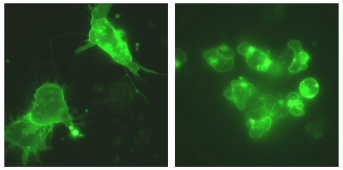Like metastasizing cancer cells, embryonal cells are capable of migrating and penetrating into other tissues. Based on studies of frog embryos, KIT scientists have now proved for the first time that a known compound, cadherin-11, is decisive for cell migration. This glycoprotein is also responsible for the erroneous cell behavior in case of prostate cancer and arthritis. The results were published in the latest edition of Genes & Development (issue 23 (12), June 15, 2009, DOI No. 10.1101/gad.519409).
Normally, cadherins have the task to link cells. “In principle, they are working like a zipper and link cells to form a cell composite or tis-sue,” explains Professor Doris Wedlich, Head of the KIT Zoological Institute II. The molecules prevent the cells from detaching and emi-grating from the cell composite. Cadherin-11, one of the about 300 cadherins known in vertebrates, however, behaves exactly the other way around in tumor cells in particular: It initiates migration. “Its presence causes the formation of cell tails or “fingertips” that explore with their sense of touch the appropriate migration path”, says Wedlich. KIT scientists studied the question why it is this cadherin that stimulates the tumor cells to migrate. For this purpose, they investigated the functioning of cadherin-11 in neural crest cells, i.e. early embryonal cells that migrate towards the face field among others in order to form face bones. “In early embryonal develop-ment, surprising parallels to tumors can be found”, explains the de-velopmental biologist Wedlich. Embryonal cells represent an inter-esting model system to study tumor formation, as their behavior is controlled by the same principles: A tumor is characterized by un-controlled growth, which means unhindered cell division. Its cells do no longer fulfill their original task and change their shape. They re-assume old properties, for instance, the tendency to migrate and penetrate into foreign environment.
Only recently were indications found of the fact that cadherin-11 plays a role in the metastasis formation of cancer and the initiation of arthritis. However, its functioning mechanism has not yet been understood. “Now, it becomes clearer why cadherin-11 is found on prostate tumor cells that preferably metastasize into the bone tis-sue”, says Wedlich. “A similar mechanism seems to occur in the inflammation of joints. Cadherin-11 helps cells that line the joint capsule to erroneously colonize the bone.” With the help of molecu-lar biology methods, the team headed by Professor Wedlich found that the bonding of specific adaptor proteins to cadherin-11, namely, of trio together with beta-catenin, only initiates the formation of cell tails and, hence, the migration of the cell. Using genetically modified cadherin molecules which lacked certain sections, the scientists succeeded in localizing the bonding region of trio in cadherin. “In the cell, trio acts specifically on cadherin-11”, underlines Doris Wedlich. “To prevent the misbehavior of cells initiated by cadherin-11, it is therefore reasonable to specifically block the coupling of trio to cad-herin-11.”
At the moment, the KIT young investigator group headed by Jubin Kashef focuses on the structural features of the bonding sites of trio and cadherin-11 and on the factors activated by the coupling of both proteins. “If we succeed in answering these questions, we might interrupt the signal path and, hence, prevent the migration of the cells in the long term”, outlines Doris Wedlich.
The Karlsruhe Institute of Technology (KIT) is the merger of the Forschungszentrum Karlsruhe, member of the Helmholtz Association, and the Universität Karlsruhe. This merger will give rise to an institution of internationally excellent research and teaching in natural and engineering sciences. In total, the KIT has 8000 em-ployees and an annual budget of 700 million Euros. The KIT focuses on the knowledge triangle of research – teaching – innovation.
The Karlsruhe institution is a leading European energy research center and plays a visible role in nanosciences worldwide. KIT sets new standards in teaching and promotion of young scientists and attracts top scientists from all over the world. More-over, KIT is a leading innovation partner of industry.

